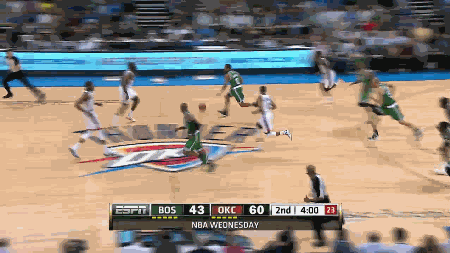When it comes to NBA draft boards, everybody loves one-and-done prospects from prominent programs. The last six No. 1 picks have fallen into those categories, all of whom were freshmen from Kentucky, Kansas, Duke or the one possible exception to the rule, UNLV (still large in its own right).
Although there’s no crystal ball that tells us the future of incoming prospects, it’s clear from scouting reports that players from small schools are going to struggle because of their lack of superior competition. It’s also obvious that three- or four-year athletes don’t have the ceiling to improve to elite levels.
Except what if that weren’t always the case? What if it turned out that talent trumped where you went to school and being a four-year prospect didn’t doom your growth from the outset of your professional career?
The Portland Trail Blazers’ C.J. McCollum is doing his part to prove that players of both categories can in fact be productive in the NBA—and that stardom is a reachable goal with a strong work ethic and when put in the right situation.
Who the hell did CJ McCollum work with in the offseason? He’s going DIRECTLY into contact and timing jumps off contact. What is happening
— Dane Carbaugh (@danecarbaugh) October 29, 2015
//platform.twitter.com/widgets.js
When McCollum first entered the league, he was, in some ways, put into an ideal situation. As a No. 10 selection, the promise of dangerous scoring and playmaking was there, but he wasn’t thrown to the wolves the way many lottery picks are. He had the luxury of playing alongside an All-Star in LaMarcus Aldridge and a soon-to-be All-Star in Damian Lillard, and he had time to develop his game behind the scenes (specifically behind Wesley Matthews) to avoid the national criticism that many first-year starters are forced to face.
But with that luxury came the frustration of transitioning to a lesser role than he was used to as a star at Lehigh. He also endured the vexation of recovering from a broken foot that kept him out more than half the year. As he recently told Bleacher Report’s Grant Hughes:
“I didn’t go through [a large role as a rookie], so I appreciate (my role now) that much more because I know what it’s like to pull up to the stadium and know that I’m not going to play that night. Or that I’m going to have people coming to watch me, and I know I’m not in the rotation. So when I do get to play, to have a role, I value it…and I understand that I don’t want to go back to my old life.”
Now, in his third year, the only way to keep McCollum out of the rotation is bizarre clerical errors. He’s competing at a level most wouldn’t expect from someone who started his career slowly—especially considering his four-year, small-ball status entering the NBA.
| MPG | PPG | FG% | 3PT% | APG | RPG | SPG | |
| 2013-14 | 12.5 | 5.3 | 41.6 | 37.5 | 0.7 | 1.3 | 0.4 |
| 2014-15 | 15.7 | 6.8 | 43.6 | 39.6 | 1.0 | 1.5 | 0.7 |
| 2015-16 | 35.5 | 20.9 | 43.9 | 39.8 | 4.4 | 3.7 | 1.2 |
Averaging career highs across the board, McCollum is a full-fledged Most Improved Player candidate in 2015-16, and the favorite in the eyes of many. Former Trail Blazers point guard Greg Anthony recently told Bleacher Report’s Stephen Nelson, “C.J. McCollum didn’t give anybody the inclination that he was going to be this good this soon based on what’d we’d seen in the past.”
And while that’s true in some respects, and helps define his MIP candidacy, we did get a taste of what the young combo guard was capable of when he went off for showings of 26 points, 18 points and 33 points in last year’s playoffs while shooting 57.1 percent, 66.7 percent and 60 percent respectively in each of those contests.
[youtube https://www.youtube.com/watch?v=1kHeKH07Vp4]What’s even more fascinating about McCollum’s story is that he’s finding success alongside another ball-dominant guard who has made a name for himself after playing four years at a mid-major program. The difference, of course, is that Lillard was a star right out of the gate. He instantly became the 1b behind LaMarcus Aldridge’s 1a, and he was just the fourth player in NBA history to unanimously earn Rookie of the Year honors.
For McCollum, it took getting healthy and finding the right opportunity to earn his spot in the rotation. But that’s what makes his breakout season that much more special. At 24 years old, the Lehigh product is proving that you don’t have to be a star as a rookie to propel your game to that type of level down the road.
Of course, it’s important to recognize that Portland’s newest starting 2-guard is the exception to the rule, not the new norm. We’re not going to see four-year players from schools we’ve never heard of start popping up across the league, and we’re certainly not going to see them join the Most Improved Player discussion on a regular basis.
No, that’s what makes one of Portland’s top leaders worthy of the praise he’s receiving this season. He’s the anomalous example of succeeding from the wrong side of a league-wide stereotype, and he’s proving he’s had what it takes to be a star for the Trail Blazers all along.
Add The Sports Daily to your Google News Feed!
